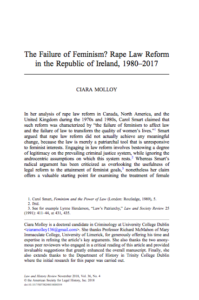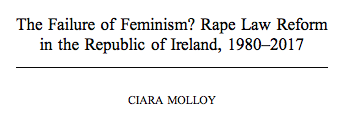Ever since I was little, I’ve had an innate fear of clowns. This was way before I ever heard of the name Stephen King, much less read any of his books, and so I can’t solely blame Pennywise for this particular fear. I’ve never been able to figure out why clowns unsettle me so much. But recently when I was preparing the final draft of my article for the Law and History Review entitled “The Failure of Feminism? Rape Law Reform in the Republic of Ireland, 1980-2017” (currently in print in volume 36.4 of the journal), it gradually dawned on me; my fear of clowns stems from the fact that I don’t consider them human. They have a smile painted on their faces, but you can never tell if they’re really happy or not. They wear oversized shoes and gloves which distort and exaggerate their real physical features. They pretend to clumsily trip over and to engage in whimsical juggling tricks which usually end badly, but deep down you know it’s all just for show and that a cunning intelligence lurks beneath their veneer of incoordination. There’s something unreal and unnatural about clowns, so much so that in my head I’ve dehumanised them and can no longer empathise with the individual behind the costume.

This is not an essay about clowns. But it is an essay which deals with the dangerous process of dehumanisation. Particularly, it’s an essay that considers the tendency of the common law system to engage in a process of dehumanisation when it comes to sexual violence, thereby providing a superficial and circuslike form of justice that is not necessarily in the best interests of the victim, offender, or society at large for that matter. Dehumanisation involves removing the individuality or positive attributes of an individual or group of people. There are three main ways in which the common law system acts a dehumanising force in the context of rape crime.
- Removes the individuality of the victim
The first is through removal of the individuality of the victim. As my journal article discusses, under the common law system the victim traditionally played a secondary role when it came to rape crime. Rape initially emerged on English statute books as a proprietary crime committed by one man against another, with the crime resulting in the depreciation in the market value of the woman who was viewed as the man’s possession. This definition of rape crime remained intact for the vast majority of eight hundred years, rendering the victim a marginal figure significant only in terms of the monetary value she represented as a form of male property. Since the 1980s a victim-centred approach to the legal system has been adopted, which led to the reconceptualisation of rape crime as a violation of bodily integrity thereby restoring the visibility of the victim to a degree. The recent introduction in the Republic of Ireland of the Criminal Justice (Victims of Crime) Act 2017, which transposes Directive 2012/29/EU of the European Parliament and Council into Irish law, further heightens the participation and welfare rights of victims.[1]
Yet the fact remains that under common law, all crime is regarded as an offence against the state rather than an offence against the victim, with the latter occupying the status as a mere witness for the state. Crime signifies a breaking of the social contract, in particular that the state should possess the monopoly on the use of force. The continued lack of separate legal representation for victims indicates that the victim continues to play a largely secondary role in a drama between the state and the offender. Despite the formula of ‘add victims and stir’ which has been introduced since the 1980s, the common law system continues to marginalise the role of the victim thereby subsuming his/her individual needs to the presumed greater good of society.
- Recasts the victim of rape as a sexual object
Removing the individuality of a victim is a dangerous practice, but far more worrying is the tendency of the common law system to engage in further dehumanisation by recasting the victim of rape as a sexual object. To illustrate this point, between January and March 2018 a highly publicised rape trial took place in Belfast in which two prominent Ulster and Ireland rugby players were accused of raping a young woman [editor’s note: the incident, trial and media coverage are summarized in the Irish Times here and in the U.S. sports blog Deadspin here. Both accounts include descriptions of sexual violence and crude language]. During the trial, messages exchanged by the accused as part of a Whatsapp group chat were read out in court. These messages were derogatory to women and loaded with sexual innuendoes; ‘love Belfast sluts’ was perhaps one of the least offensive messages written. Such rhetoric facilitates the dehumanisation of women by reducing them to mere sexual objects, which contributes to acts of rape which are premised in the degradation and humiliation of victims.
Yet while the Whatsapp messages used the language of dehumanisation, the common law trial facilitated its reproduction through use of the victim’s sexuality not merely to define her identity but also to undermine her credibility. The victim of the Belfast rape case was placed on the stand for eight days while she underwent a gruelling cross-examination and was questioned extensively about her sexual behaviour. One particular angle the defence adopted was to insinuate the victim deliberately set out on the evening in question to seduce a celebrity. CCTV footage from a nightclub showed the woman touching the knee of a footballer she was chatting to, and also briefly holding the arm of a man. In this way, the attempt was made to portray her as a sexual predator of some sort, determined to entrap any man into her snares. The insinuation was the victim chose to ‘cry rape’ when things went too far.
Though the Belfast trial took place outside the Republic of Ireland, under this adversarial system established by common law, the sexual history of the victim tends to be interrogated in the courtroom in rape trials in both the North and South of the country. Recently in Ireland under section 21 of the aforementioned Criminal Justice (Victims of Crime) Act, judges are provided with discretion to disallow questioning of the victim’s private life if there is a risk of secondary and repeat victimisation. Yet as my journal article discusses, a similar provision was introduced under the Criminal Law (Rape) Act 1981, which proved largely ineffective. Rape law reform cannot easily eliminate the centuries of sexist assumptions that underpin the common law system. The frequently-used defence strategy of attacking the credibility of the victim by depicting her as promiscuous has given rise to the term ‘secondary rape’ to describe the trauma it inflicts on victims. The very existence of such a term suggests that there is something seriously wrong with the current way in which our legal system deals with sexual violence. ‘Justice’ is supposed to involve correcting an offence rather than committing one.
- Divests the offender of humanity
In Ireland as well as internationally at the present moment, the spotlight is on the attempts of victims of sexual violence to demand meaningful forms of justice. This attention is long overdue given the invisibility of the victim from the adversarial trial prior to the 1980s. And yet, while it may be an unpopular consideration, any discussion of justice concerning rape crime must address not just the victim and society at large, but also the offender. There is an unfortunate tendency to visualise the imbuing of participation and welfare rights to the victim as a zero sum game, which can only be achieved at the expense of the erosion of the rights of the offender. Nothing could be further from the truth, as these rights are not mutually exclusive. A balance between the rights of both victim and offender can be achieved, and indeed must be achieved, for any form of justice to be meaningful. Otherwise, the legal system simply victimises offenders and contributes to a mere spectacle of justice in which offenders are castigated and shunned with no attempt to achieve deeper understanding of their actions.
Given the above, while the dehumanisation of the convicted rapist can sometimes be the elephant in the room when it comes to discussions on sexual violence, it is also important to take this aspect of the common law system into account. It is my belief that the common law system, in addition to being ill-equipped to deal with rape crime, preserves rather than deconstructs the monster we associate with sexual violence as it provides no explanation for the behaviour of the offender and provides no meaningful opportunity for the victim to engage with the offender to help dissolve this monstrous image. In this way the form of justice it provides is destructive rather than transformative. Rape trials create bifurcated categories in which the accused is either guilty or not guilty, but often the label of sex offender becomes attached either way and is difficult to remove. If found guilty, the offender will usually be given a custodial sentence and sent to Arbour Hill or the Midlands Prison alongside other convicted sex offenders. Reintegration into the community once the sentence has been served becomes more difficult because of the initial label assigned by the courts and the reification of this label throughout the incarceration period.
Similarly, a defendant found not guilty, as in the case of the defendants in the Belfast rape case, may find it challenging to escape stigmatization. Within months of the trial’s conclusion in March 2018, the contracts of the two rugby players were revoked by Ulster Rugby and the Irish Rugby Football Union, and they left Ireland to play for French clubs. Whether guilty or not guilty, defendants in rape trials are often castigated as monsters which is unhelpful to the victim seeking closure, the convicted offender seeking to rehabilitate, the acquitted defendant seeking to return to normality, or the wider community seeking to reintegrate the offender. Sexual violence is not perpetrated by monsters, it is perpetrated by humans; the majority of rapes are committed by a person known to the victim rather than a proverbial monster hiding in the bushes. Nils Christie has written that ‘the pictures of monsters are difficult to preserve if you come to know them…when we understand somewhat more of people’s behaviour, particularly when, or if, we are able to see ourselves in the other person’s behaviour, then the monster dissolves.’[2] It may be comforting to pretend that rape is committed only by individuals who are truly evil, but such a view inhibits and indeed dissuades understanding of the offence from the perspective of the perpetrator as well as the victim. The common law system through dehumanisation of the offender engages in the creation of monsters, and so provides a bitter form of justice which preserves fear and hatred rather than facilitating understanding of the perpetrator’s behaviour.
Solution: Restorative Justice
During a trapeze performance, an acrobat engages in an increasingly dangerous series of feats which leaves the audience anxious and riveted. But the anxiety of the crowd is offset by the presence of a safety net just below the line of sight which will catch the acrobat if something goes wrong. The audience can leave the circus tent content in the knowledge that the performance was successfully completed, and that the spectacle was simply that – a spectacle. Through dehumanisation of victims and offenders, the common law rape trial similarly acts as an empty spectacle by providing a form of justice that encourages fear and marginalisation rather than empathy and healing. But there is a viable alternative to this current reality of rape trials under the common law system, namely restorative justice.
Restorative justice is a culturally transformative process which seeks to repair the harm caused by criminal offences to individuals, families and the wider community. It is a therapeutic means of justice and can take various forms including victim-offender mediation, restorative conferencing and restorative circles. While the formal criminal justice system regards a crime as an offence against the state, restorative justice sees crime as harm caused to a victim and so seeks to empower the voice of that individual. In this way, restorative justice is a humanising process which facilitates communication, empathy and even healing between victims and offenders.[3] John Braithwaite explains that while the common law system engages in stigmatization, which labels an offender and makes community re-integration less likely, restorative justice engages in reintegrative shaming which criticises the crime rather than the offender.[4] It facilitates the expression of emotion and encourages the offender to take responsibility for his/her actions and to take steps to make amends for the harm caused. It also enables the emergence of a constructive social dialogue allowing for an enhanced understanding of the motivations, nature and consequences of rape crime. Only through this shared understanding laying out the boundaries of acceptable sexual conduct and the meaning of consent can we hope to reduce the prevalence of sexual violence. Restorative justice provides the platform for such an understanding to take root.
Yet at present in the Republic of Ireland, restorative justice merely acts as the safety net to the circus performance of the common law rape trial as it is used as a complement rather than alternative to the common law system, which strongly detracts from its potential.[5] The framework for restorative justice first emerged on a statutory basis in 2001 when the Children’s Act introduced it for youth offenders. In March 2007 Minister for Justice Michael McDowell appointed a National Commission on Restorative Justice which reported in 2009 and recommended the use of restorative justice be made more widely available for certain offences involving adult offenders. Yet the Commission was reluctant to advocate the use of restorative justice in cases of sexual violence until a pilot programme was undertaken.[6] In 2014 a report conducted by Marie Keenan supported the extension of restorative justice for sexual violence cases, similar to Project Restore in New Zealand and the Assessment, Intervention, Moving On project in Manchester. One particularly notable line of this report articulates that ‘the power of restorative justice lies in its humanising potential’,[7] but as of yet this potential has not been fully realised by the Irish state. Granted, since 2015 restorative programmes such as Circles of Support and Accountability [COSA] have been used in the Republic of Ireland for sex offenders, and have reported a 70% reduction in the likelihood of recidivism.[8] Yet COSA does not involve direct interaction between offender and victim, and there is a need to use restorative justice as an alternative to instead of a complement to the traditional adversarial system.
Restorative justice is by no means a magical panacea for all problems facing the common law system when dealing with rape crime. But it is a viable alternative which deserves to be further explored. Because the current reality is that a rape trial under common law system resembles little more than a circus. Different actors may be involved in different trials, but the underlying script remains the same – attack the credibility of the victim, and do this by using sexual history evidence to portray her as promiscuous. Certain trials such as the Belfast rape trial may capture the public attention and generate criticism of the current manner in which rape victims are treated, but unless we learn lessons from this episode, it has just acted as a dismal form of entertainment for the masses. No rape trial should ever be viewed as such. Through dehumanisation of both victims and offenders, the common law system partakes and reproduces the sexist assumptions that contribute to rape crime in the first place, while castigating both convicted offenders and acquitted defendants as monsters which is of little help to anyone involved. Unless we restore humanity to rape trials, we are breeding a culture of marginalisation and fear. Now, more than ever, it’s time to take back the circus of the common law system when it comes to rape crime, and instead move towards the more culturally transformative and humanising process of restorative justice.
Notes:
[1] Criminal Justice (Victims of Crime) Act, 2017, No. 28.
[2] Nils Christie, A Suitable Amount of Crime (London: Routledge, 2004), 50.
[3] Jonathan Doak, “Honing the stone: Refining restorative justice as a vehicle for emotional redress,” Contemporary Justice Review 14 (2011): 439-456.
[4] John Braithwaite, “Restorative Justice and Therapeutic Jurisprudence,” Criminal Law Bulletin 38 (2002): 244-262, at 258.
[5] For further discussion of this issue, see Anne-Marie McAlinden, “’Transforming justice:’ Challenges for restorative justice in an era of punishment-based corrections,” Contemporary Justice Review 14 (2011): 383-406.
[6] National Commission on Restorative Justice, Final Report (Dublin: Department of Justice, 2009), 21.
[7] Marie Keenan, Sexual Trauma and Abuse: Restorative and Transformative Possibilities? A Collaborative Study on the potential of Restorative Justice in Sexual Crime in Ireland (Dublin: University College Dublin, 2014), 28.
[8] The Irish Times, 9 November 2013, 3; The Irish Times, 20 October 2016, 7.



